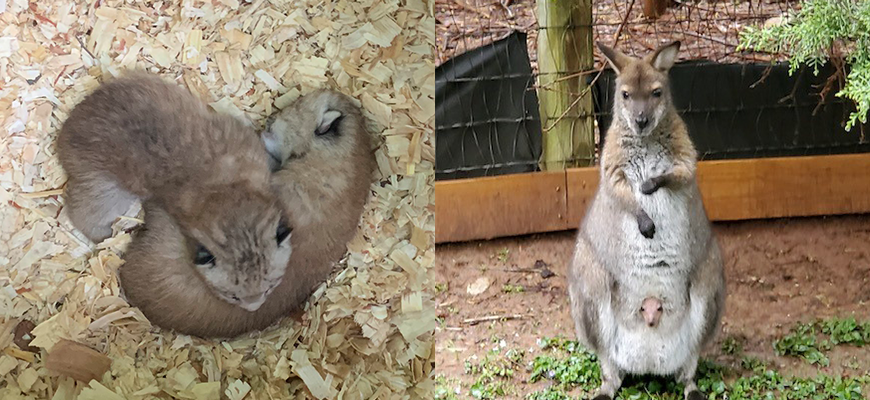ZOO CONTACT: Kyle Shepherd
502-238-5331 (Media Cell 502-744-5639)
kyle.shepherd@louisvilleky.gov
The Zoo’s spring “baby boom” continues with the birth of three Canada lynx kittens born on May 19, 2022 to mother Matilda and father Sitka. In addition, the Zoo recently welcomed four Bennett’s wallaby joeys. Three of the joeys can be seen peeking from or hopping in and out of their mothers’ pouches in the Australia zone.
Canada lynx Matilda will care for her kittens in a nest box during the first few weeks. Guests will be able to see the box and can expect to start seeing the kittens moving around the Americas’ exhibit in approximately 3– 4 weeks or near late June. The genders of the kittens won’t be known until after their first exam, which will be performed when they are closer to six weeks old to avoid disrupting the bonding process.
Because wallabies spend a significant amount of time during their first nine months concealed in their mom’s pouches, the wallaby joeys will be seen either in mom’s pouch or less frequently, in the yard. One male joey is being hand-reared off exhibit due to an early departure from mom’s pouch and need for additional care. The genders of the other three wallabies will be known once they have fully emerged from the “pouch life.”
The Wallaroo Walkabout hours may vary. Visit louisvillezoo.org/today for the latest information on times.
Follow the growth of these newest animal ambassadors at louisvillezoo.org/zoobabies. Presented by Norton Children’s, Zoo Babies spotlights recent births at the Zoo including harbor seal Emmy, our new zebra filly, and impending giraffe birth, and more. Zoo Babies reminds us that every animal birth is important and an opportunity to “better the bond between people and our planet.” To learn more about the program, visit louisvillezoo.org/zoobabies.
About Canada Lynx and Bennett’s Wallabies
Canada lynx are the most common and widespread feline in Canada. Compared to the bobcat, the lynx has longer legs and broader footpads for walking in deep snow. They are characterized by their ear tufts which are just as sensitive as whiskers, and the slightest breath of wind can be detected as a result. Females weigh between 18 and 24 lbs., with males slightly larger at 20 – 30 lbs.
Bennett’s, or red-necked wallabies, are named for their rusty red shoulders and upper backs. This kangaroo relative is found in east and southeast Australia and Tasmania. Small in stature, wallabies stand between 36 – 40 inches tall. They are herbivores and primarily feed on grasses, herbs, and roots, which provide additional water during droughts. Being marsupials, wallabies have a pouch and give birth to undeveloped young, called joeys, which can weigh only 2 grams at birth.
***
About the Louisville Zoo
Since 2011, under Mayor Fischer’s administration, the Louisville Zoo celebrated its 50th anniversary, opened nine new exhibits and attractions, and won national awards for Glacier Run and School at the Zoo. Considered Kentucky’s most popular not-for-profit paid attraction, the Zoo welcomed nearly 9 million guests in the last decade. In 2021, the Zoo was voted “Best Place to Take Kids in Summer,” by LEO Weekly, “Best Kid-Friendly Attraction” by Kentucky Living Magazine and Boo at the Zoo made the Top 10 Halloween Festivals list by thetravel.com. Community Access Memberships, deep-discount days, the Future Healers Got Zoo Buddies partnership and the accessible playground are among prime efforts to make Louisville Zoo even safer, more engaging, and more inclusive. Among the Louisville Zoo’s most successful conservation programs, the black-footed ferret breeding effort produced 1,100 kits and repatriated more than 800 of these most highly endangered, American mammals to the wild.
The Louisville Zoo, a non-profit organization and state Zoo of Kentucky, is dedicated to bettering the bond between people and our planet by providing excellent care for animals, a great experience for visitors, and leadership in scientific research and conservation education. The Zoo is accredited by the Association of Zoos and Aquariums (AZA).
# # #

